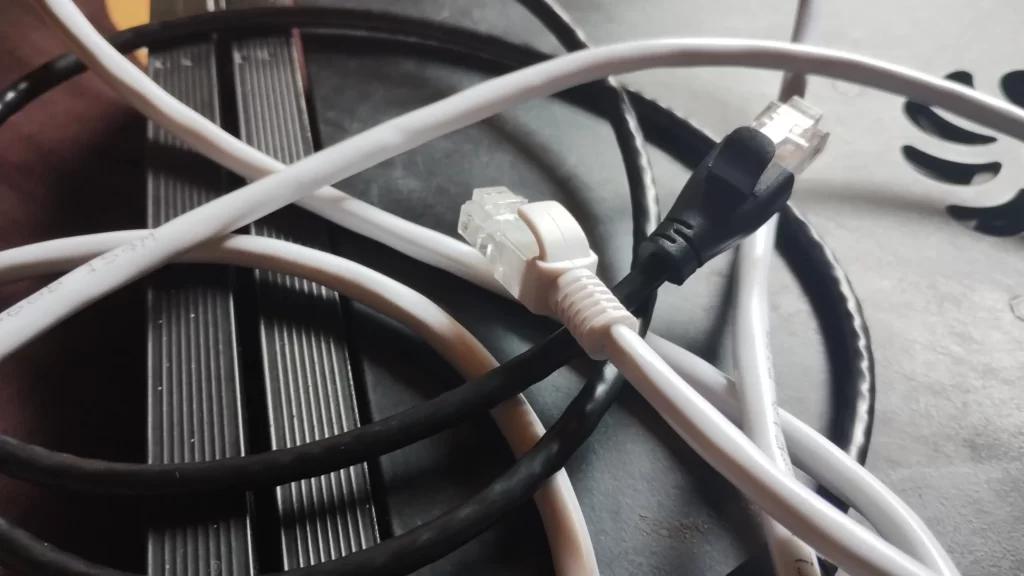One of the concerns of whatever cables we run in our house is always about fire, especially if the structure of your building is easy for cables to catch fire.
Similarly, when we run ethernet cables, fire thoughts often come to our mind because it is a critical situation everybody wants to avoid.
So, Can Ethernet Cables Cause Fire?
Ethernet cables usually don’t cause fire as the voltage of the ethernet cables is low, which makes it safe from starting a fire. However, ethernet cables can catch fire from other sources, but the chances of starting a fire from ethernet cables are low.
If we talk about the POE or Power Over Ethernet cables, they are also categorized as low voltage; they generally transfer 47 volts to 57 volts, which is low and can hardly start a fire.
With POE or Power Over Ethernet cables, you can only run low-voltage devices; thus, you are much away from starting a fire.
But, there is an issue, if you run ethernet cable in an environment with open-air spaces, where the chances of spreading fire are high, you’ve to use a special type of ethernet cable that I’ve mentioned below.
So, let’s read some more crucial info to stay protected always!
Do Ethernet Cables Carry Electricity or Power?
Yes, ethernet cables do carry electricity or power to transfer data, but it is in small amounts, which doesn’t cause any serious issues. Although all the wires don’t transmit data in ethernet, the extra wires can transfer power.
If you use Gigabit, they use all the pairs to send data, which serves more speed and stable connection.
So, now coming back to the point, how much electricity does an ethernet carry?
The amount of electricity that ethernet carries depends on what type of cable you are using. Normal standard ethernet cables carry a small amount of electricity of 2.5 volts from the pairs, which is a little more than a small 1.5v pencil battery, whereas a PoE can carry up to 47 to 57 volts.
PoE is an ethernet cable that can carry data and power simultaneously for various devices such as IP cameras, VOIP phones, and others.
Various types of ethernet cables have different amounts of electricity transferring capability; therefore, it is advised to look before buying.
Can a Damaged Ethernet Cause Fire?
Likely No! As mentioned earlier, ethernet cables may not cause a fire even if damaged or broken due to the low voltage. However, a damaged ethernet cable causes various other issues related to data transfer, like packet loss, performance drop, and others.
So you don’t need to worry about fire if your ethernet connection is old and quite damaged; however, it is better to replace the cable.
In the case of a POE or Power over ethernet cable, which is damaged can affect or damage your equipment connected with the POE.
Hence, you’re again safe from fire with an ethernet cable.
Ethernet Cables in a Fire-Rated Environment
Although ethernet cables don’t directly cause fire, as said earlier, but they can catch fire for sure, and the main concern is that ethernet cables leave toxic fumes when they burn, making a critical situation worse due to their PVC jacket.
What Kind of Toxic Fumes Do Ethernet Cable Leaves?
- Hydrochloride
- Dioxin
- Halides
- Others [depending on the cable jackets]
When the cable burn and these toxic fumes leave, they cause harm to humans.
Thus, you must be careful when running ethernet cables through an open-air environment or other fire-hazard spaces. Here I’ve listed a few types of ethernet cables for different situations [from fire-rated environments to non-fire-rated areas];
#1 Plenum Ethernet Cables [CMP]
As the name suggests, this type of ethernet cable is for Plenum areas [drop and structural ceiling], where we have a lot of airflows continuously; this area is a fire hazard.
So the Plenum Ethernet cables are approved by various electronics associations to use in fire hazard places, like plenums.
The wires of the plenum cables are also quite fire resistant, and the jackets of the plenum cables don’t leave so many toxic fumes when they burn because the jacket is made with a different type of plastic which is coated with Teflon FEP [it prevents or slow down the fire].
Toxic fumes can cause real harm to humans.
Hence, buildings with plenum areas or other areas with such open airflow must use plenum ethernet cables to stay protected from any difficult situations.
Though Plenum cables are quite expensive, they are approved for use in fire hazard areas. These cables are mostly seen in commercial areas.
#2 Non-Plenum Cable
Non-Plenum cables are used for non-plenum areas or areas not directly exposed to airflow, but the air is circulated through the air ducts.
As the air circulates from the ducts, the chances of catching fire in those areas are low, and the circulation of toxic fumes too.
So for such areas, we use Non-Plenum ethernet cables; these cables are not as expensive as plenum.
The non-plenum cables have PVC jackets and leave toxic gas when burned, and the cables are also not that much fire flame retardant. Thus, it is advised not to use these cables in plenum areas.
#3 CMR or Riser Cables
Riser ethernet cables are the most used or popular cables for house wiring. This type of cable runs between floors in a building vertically.
CMR-rated cables are not as fire retardant as Plenum rated cables. Thus, Riser cables should not be used in Plenum areas; it is mostly used in walls.
Although, these cables are run through risers to prevent fires. Riser cables do leave toxic gases if burned. These cables are also cheap than plenum cables.
#4 CM Cables
For general works, we use these CM ethernet cables. We mainly connect this cable from the wall jack to our devices [computers, laptops, and others]. CM or communication multipurpose cables are not as fire retardant as the other 3 mentioned above.
These cables are the cheapest, and we use them in our rooms for regular work. These cables have the lowest safety standard.
Thus, you have to select in what kind of environment you’re running your ethernet cable, and according to that, you should select the cable type.



